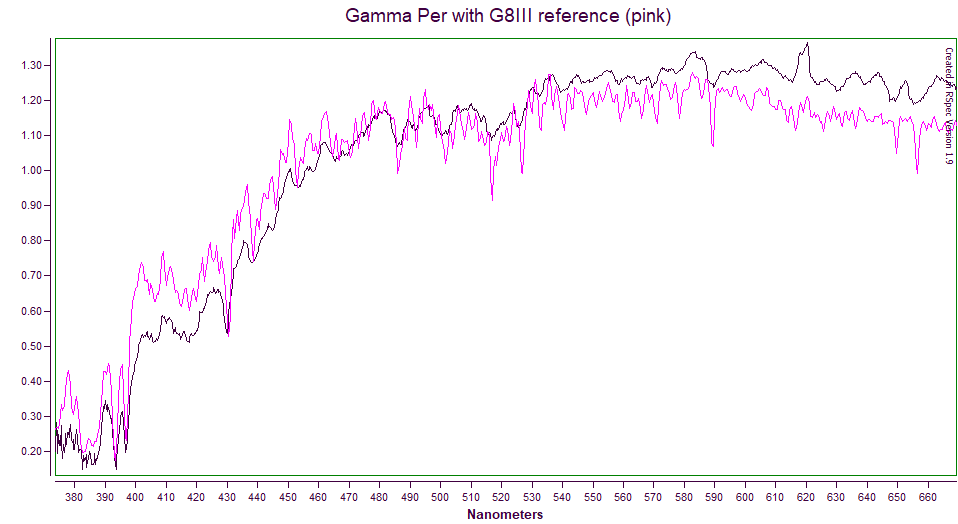Page 2 of 3
Re: Staranalyzer et polynôme...
Posted: Fri Nov 15, 2019 9:37 am
by etienne bertrand
Hello Robin, i try with the zéro order and the dispersion but there is big problem, i put a exemple soon as possible..
Re: Staranalyzer et polynôme...
Posted: Fri Nov 15, 2019 2:08 pm
by Robin Leadbeater
Hi Etienne,
Can you post some images or send them to me (I think the forum accepts fits in a zip file) and I will have a look. I can use them show the steps in VSpec
Cheers
Robin
Re: Staranalyzer et polynôme...
Posted: Fri Nov 15, 2019 7:55 pm
by etienne bertrand
Hello Robin,
The spectr of the staranalyzer with C8 + red x0.63 and Atik314L+
I found a dispertion ~14.55A/px
Re: Staranalyzer et polynôme...
Posted: Fri Nov 15, 2019 11:44 pm
by Robin Leadbeater
etienne bertrand wrote:Hello Robin,
The spectr of the staranalyzer with C8 + red x0.63 and Atik314L+
I found a dispertion ~14.55A/px
Hello Etienne,
I started with Vega and found a linear dispersion of 14.7A/pixel by making a 2 point calibration in Vspec using the zero order and H beta (4861A)
I then applied this calibration to some of the other spectra using a 1 point calibration in Vspec
The resulting spectra look well calibrated (see the zip file for a description of the method and some raw wavelength calibrated spectra)
Cheers
Robin
Re: Staranalyzer et polynôme...
Posted: Fri Nov 15, 2019 11:51 pm
by Robin Leadbeater
Robin Leadbeater wrote:
The resulting spectra look well calibrated
Robin
for example here is your WR136 spectrum compared with Christian's spectrum using a LISA from
http://www.astrosurf.com/buil/survey/wr ... html#WR136

- _wr136_20111017_819.png (5.97 KiB) Viewed 8251 times
Cheers
Robin
Re: Staranalyzer et polynôme...
Posted: Sat Nov 16, 2019 10:01 am
by etienne bertrand
Hello Robin,
Exellent !
I find the same dispertion.
When you calibrate with 1 ray, with the zéro order, you must tchek the board :
- wavelenght : you indicate 0
- barycentre : you indicate the number of the pixel
- dispertion : you indicate 14.55 ?
is it good ?
Re: Staranalyzer et polynôme...
Posted: Sat Nov 16, 2019 11:48 am
by Robin Leadbeater
etienne bertrand wrote:
When you calibrate with 1 ray, with the zéro order, you must tchek the board :
- wavelenght : you indicate 0
- barycentre : you indicate the number of the pixel
- dispertion : you indicate 14.55 ?
is it good ?
Yes (The Barycentre of the zero order is calculated for you if you select the zero order first, before you open the window)
VSpec remembers the wavelength and dispersion so usually it is already filled in but it is good to check.
(I first check that the other Balmer lines in the reference star are in the right place. It is sometimes possible to get a better fit on average to all the lines by changing the dispersion slightly. For example I used a dispersion of 14.7. You used 14.55. This is a difference of 1% or 65A at H alpha or ~4 pixels)
Cheers
Robin
Cheers
Robin
Re: Staranalyzer et polynôme...
Posted: Sat Nov 16, 2019 6:19 pm
by Robin Leadbeater
Olivier Thizy also made a nice description in French for processing Star Analyser spectra using VSpec here
http://www.spectro-aras.com/forum/viewt ... ?f=8&t=460
the link to the pdf document is broken but here is a copy (Thanks Olivier! I hope you dont mind

Robin
Re: Staranalyzer et polynôme...
Posted: Sat Nov 16, 2019 10:41 pm
by etienne bertrand
Many thank Robin,
I think i'm OK now with the staranalyzer !! I'm OK for science now.
Very nice little greating !
Re: Staranalyzer et polynôme...
Posted: Fri Dec 06, 2019 5:50 pm
by James Ley
Robin Leadbeater wrote:etienne bertrand wrote:Ce que je fais quand je ne connais pas les raies du spectre de l'étoile, je cherche son type spectral et je charge le spectre de référence du type spectral de l'étoile et je calibre sur les raies mesurées avec le spectres de référence...
Voici la constellation de Cassiopée
Bertrand.This is crazy!

Why are you even taking the spectra if you already need to know what it is ?? This is science, not like astrophotography where people try to make their image look like the one in the book

Ignore the advice not to use the zero order. The zero order is the only common reference point you have. Use it with the linear dispersion and your calibration will be close enough.
Cheers
Robin
I think there are some good reasons to not use the zero order. I can achieve far higher resolution with my small CMOS camera (ASI290MM).
The common reference is, in fact, the dispersion, which doesn’t change. I begin by building a polynomial using the Balmer lines from an A-type star.
Then I add in the Ca II K and H lines and Na I D line from an F- type star
At this point I have a polynomial function for the dispersion, which is the same for all stars. I calibrate an unknown star using one point: H-beta for stars O-A, Ca I K for F-type stars and Na I D for K-type and G-type. I don’t need to know the spectral type of the unknown star, I have never had a problem with trial and error.

- 7F103D59-86A2-47B3-966F-809A51226362.png (18.9 KiB) Viewed 7894 times

- 6B364BA2-F8CF-434A-B5FE-6D4BEBE38D64.png (18.44 KiB) Viewed 7894 times
All these spectra were taken with a simple easy to use system: Borg 55mm on a camera tracker. No guiding. 5-10s exposures acquired with ASI290MM-Cool and stacked.
Why are you even taking the spectra if you already need to know what it is ?? This is science, not like astrophotography where people try to make their image look like the one in the book
